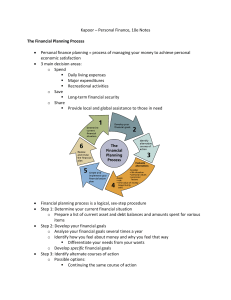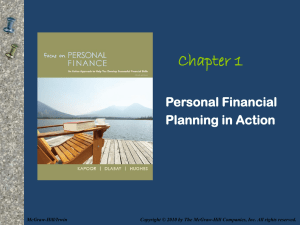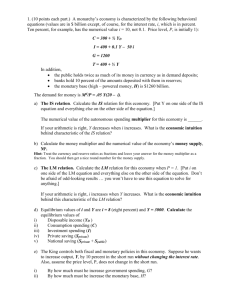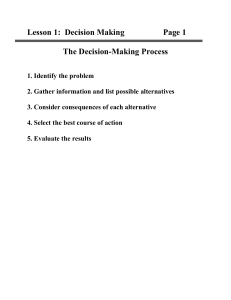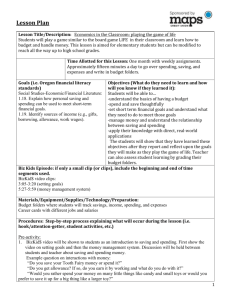CHAPTER 1 LECTURE OUTLINE
advertisement
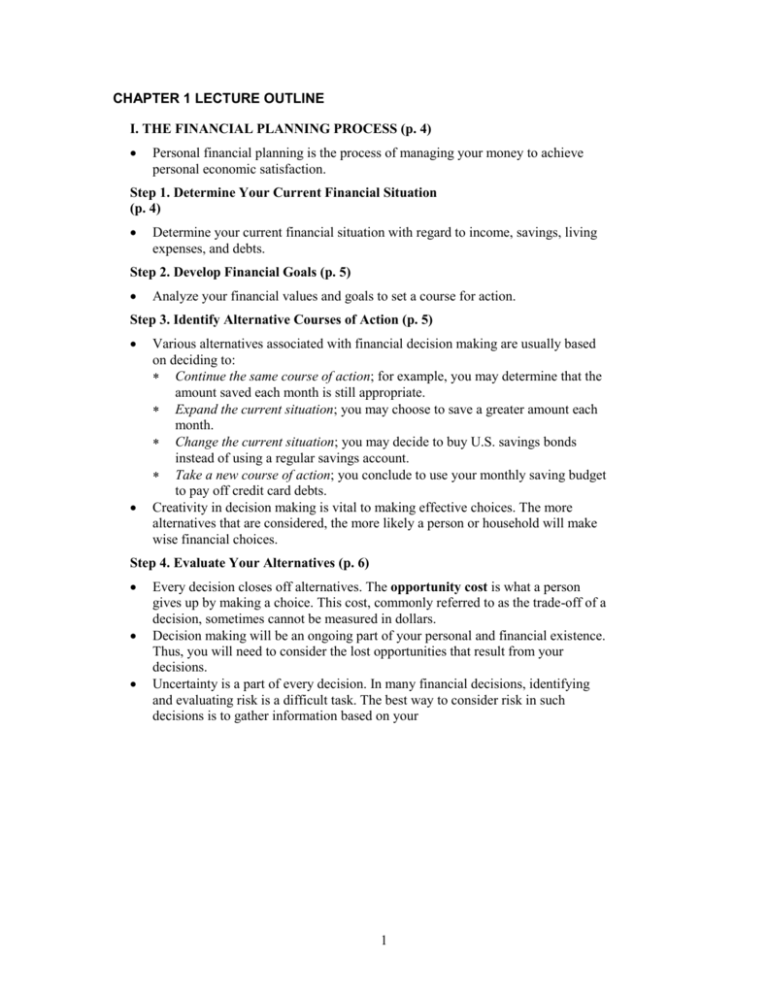
CHAPTER 1 LECTURE OUTLINE I. THE FINANCIAL PLANNING PROCESS (p. 4) Personal financial planning is the process of managing your money to achieve personal economic satisfaction. Step 1. Determine Your Current Financial Situation (p. 4) Determine your current financial situation with regard to income, savings, living expenses, and debts. Step 2. Develop Financial Goals (p. 5) Analyze your financial values and goals to set a course for action. Step 3. Identify Alternative Courses of Action (p. 5) Various alternatives associated with financial decision making are usually based on deciding to: Continue the same course of action; for example, you may determine that the amount saved each month is still appropriate. Expand the current situation; you may choose to save a greater amount each month. Change the current situation; you may decide to buy U.S. savings bonds instead of using a regular savings account. Take a new course of action; you conclude to use your monthly saving budget to pay off credit card debts. Creativity in decision making is vital to making effective choices. The more alternatives that are considered, the more likely a person or household will make wise financial choices. Step 4. Evaluate Your Alternatives (p. 6) Every decision closes off alternatives. The opportunity cost is what a person gives up by making a choice. This cost, commonly referred to as the trade-off of a decision, sometimes cannot be measured in dollars. Decision making will be an ongoing part of your personal and financial existence. Thus, you will need to consider the lost opportunities that result from your decisions. Uncertainty is a part of every decision. In many financial decisions, identifying and evaluating risk is a difficult task. The best way to consider risk in such decisions is to gather information based on your 1 CHAPTER 1 LECTURE OUTLINE experiences and those of others and refer to the research of financial planning sources. Relevant information is required at each stage of the financial planning process. Step 5. Create and Implement Your Financial Action Plan (p. 8) Develop a plan of action to achieve your goals. Step 6. Review and Revise Your Plan (p. 8) Decision making is a circular, ongoing process in which current decisions influence future choices. II. DEVELOPING PERSONAL FINANCIAL GOALS (p. 9) Many Americans have money problems due to: poor planning weak financial habits extensive numbers of marketplace influences in the form of advertising, selling efforts, and product availability. Types of Financial Goals (p. 9) Short-term goals are those to be achieved within the next year or so, such as saving for an annual vacation or paying off small debts. Intermediate goals have a time frame of two to five years. Long-term goals involve financial plans that may be more than five years off, such as retirement and college savings. Consumable-product goals usually occur on a periodic basis involving items used up relatively quickly, such as food, clothing, or entertainment spending. Durable-product goals usually involve infrequent, expensive items, such as appliances, motor vehicles, and sporting equipment. Most durable goals consist of tangible items. In contrast, however, many people overlook intangible goals. These goals may relate to personal relationships, health, education, and leisure. Goal setting for these life circumstances is also necessary for a person’s overall well-being. Goal-Setting Guidelines (p. 10) Goal setting is at the center of financial decision making. Financial goals should: 1. be realistic 2. be stated in specific, measurable terms 3. have a time orientation 4. imply the type of action to be taken 2 CHAPTER 1 LECTURE OUTLINE III. INFLUENCES ON PERSONAL FINANCIAL PLANNING (p. 13) The financial planning environment is affected by life situation, personal values, and economic factors. Life Situation and Personal Values (p. 13) The personal factors include your age, income, size of household, and your attitudes and beliefs. Your life situation is affected by various personal events (see list on p. 12). Values are personal beliefs and ideas that a person considers correct, desirable, and important. Economic Factors (p. 13) Economic conditions (supply and demand, prices, and interest rates) and economic institutions (business, labor, and government) also affect personal finance. Economics is the study of how wealth is created and distributed. The price of a specific good or service is determined by supply and demand. Just as high demand for a consumer product forces its price up, a high demand for money forces interest rates up. This price of money reflects both the limited supply of money and the demand for it. Banks, savings and loan associations, credit unions, insurance companies, and investment companies facilitate financial activities in our society. The Federal Reserve System, referred to as The Fed, is our central banking system. It influences the money supply by borrowing funds, changing interest rates, and buying or selling government securities. The spending by Americans for foreign goods and services and the investment in our country by foreign companies affect the interest rates and prices in our society. Consumer prices, consumer spending, interest rates and other economic factors affect the financial planning environment. Inflation is a rise in the general level of prices. In times of inflation, the buying power of the dollar decreases. The main cause of inflation is an increase in demand without a comparable increase in supply. Inflation is most harmful to people who live on fixed incomes. 3 CHAPTER 1 LECTURE OUTLINE The rule of 72 can be used to determine how fast prices will double; divide 72 by the current inflation rate. For example, with inflation of six percent, prices will double in 12 years (72 / 6 = 12). Consumer spending is the total demand for goods and services in the economy; this influences employment opportunities and potential for income. Interest rates represent the cost of money. Like everything else, money has a price. The forces of supply and demand influence interest rates. As the amount saved and invested by consumers increases the supply of money, interests rates tend to decrease. But as consumer, business, government, and foreign borrowing increases the demand for money, interest rates also tend to increase. IV. OPPORTUNITY COSTS AND THE TIME VALUE OF MONEY (p. 16) In every financial decision, you will sacrifice something in order to obtain something else that you consider desirable. Opportunity costs may be viewed in terms of both personal and financial resources. Personal Opportunity Costs (p. 17) The most common personal opportunity cost is time. Time spent in studying, working, or shopping cannot be used for other activities. Financial Opportunity Costs (p. 17) Like time, money allocated for one purpose cannot be used for another. The time value of money refers to the increase of an amount of money as a result of interest earned. Computation of interest is based on: the amount of the savings the annual interest rate the length of time the money remains deposited. Future value, also referred to as compounding, is the amount to which current savings will increase based on a certain interest rate and a certain time period. Future value calculations may be used for both a single amount and equal deposits. (See Exhibit 1-8.) Present value, also referred to as discounting, is the current value for a future sum based on a certain interest rate and a certain time period. Present value calculations may also be used for both a single amount and a series of amounts. (See Exhibit 1-8.) 4 CHAPTER 1 LECTURE OUTLINE V. ACHIEVING FINANCIAL GOALS (p. 20) Throughout life, each individual has needs that the intelligent use of available financial resources can satisfy. Financial planning involves deciding how to obtain, protect, and use those resources. Components of Personal Financial Planning (p. 21) The eight major components of personal financial planning are: 1. obtaining financial resources 2. planning for current living expenses and future financial security 3. saving for emergencies, unexpected bills, replacement of major items, and special purchases 4. borrowing in a responsible manner 5. spending to meet daily living needs 6. managing risk through insurance decisions 7. investing for long-term financial security 8. retirement and estate planning Developing a Flexible Financial Plan (p. 24) A financial plan is a formalized report that summarizes your current financial situation, analyzes your financial needs, and recommends a direction for your financial activities. Financial activities may be organized on the basis of spending, saving, investing, and borrowing decisions. Implementing Your Financial Plan (p. 24) The most important strategy for success is the development of financial habits that will contribute to both short-term satisfaction and long-term financial security. Using a set spending plan will help you stay within your income while you save and invest for the future. Studying Personal Finance (p. 24) Read and study the book Watch the media; talk to experts; search the web. 5
